A Citizen-Contributed GIS Approach for Evaluating the Impacts of Land Use on Hurricane-Harvey-Induced Flooding in Houston Area
Abstract
1. Introduction
2. Materials and Methods
2.1. Study Area
2.2. Land Use Data and Class Regroup
2.2.1. Land Use Database
2.2.2. Land use Class Regroup
2.3. Hurricane Harvey Flooding Data
2.3.1. Dartmouth Flood Observatory Flooding Data
2.3.2. Citizen Science Contributed Flooding Data
2.3.3. Assessing the Patterns of Flooding Data Sources and Combining Them
2.4. Precipitation Interpolation Map and Topographic Wetness Index
2.5. Modeling Framework
3. Results
3.1. Hurricane-Harvey-Induced Flooded Regions and Floodplains under Different Land Uses
3.2. Factors Influencing Harvey-Induced Flooding
4. Discussion
5. Conclusions
Author Contributions
Funding
Acknowledgments
Conflicts of Interest
Appendix A

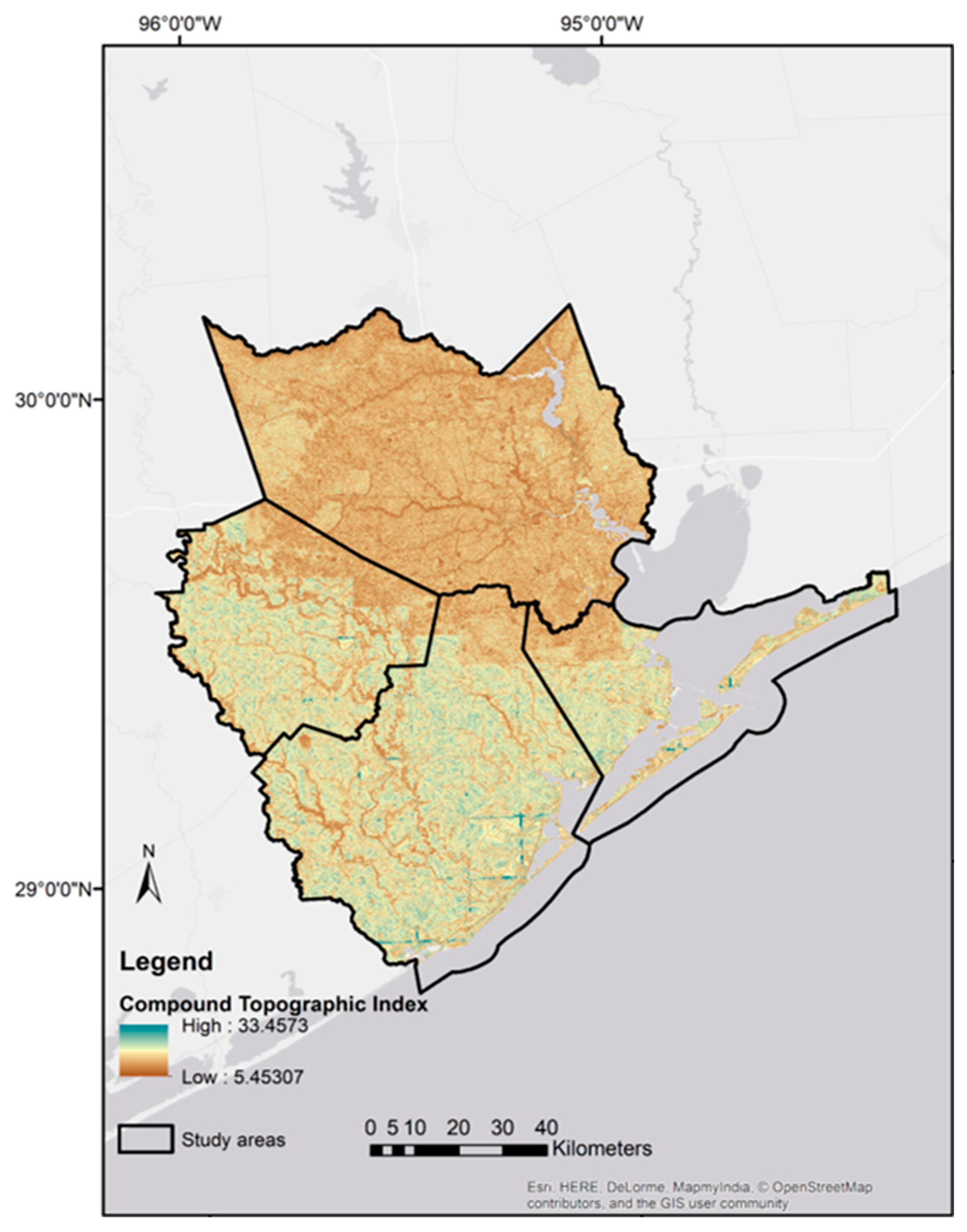
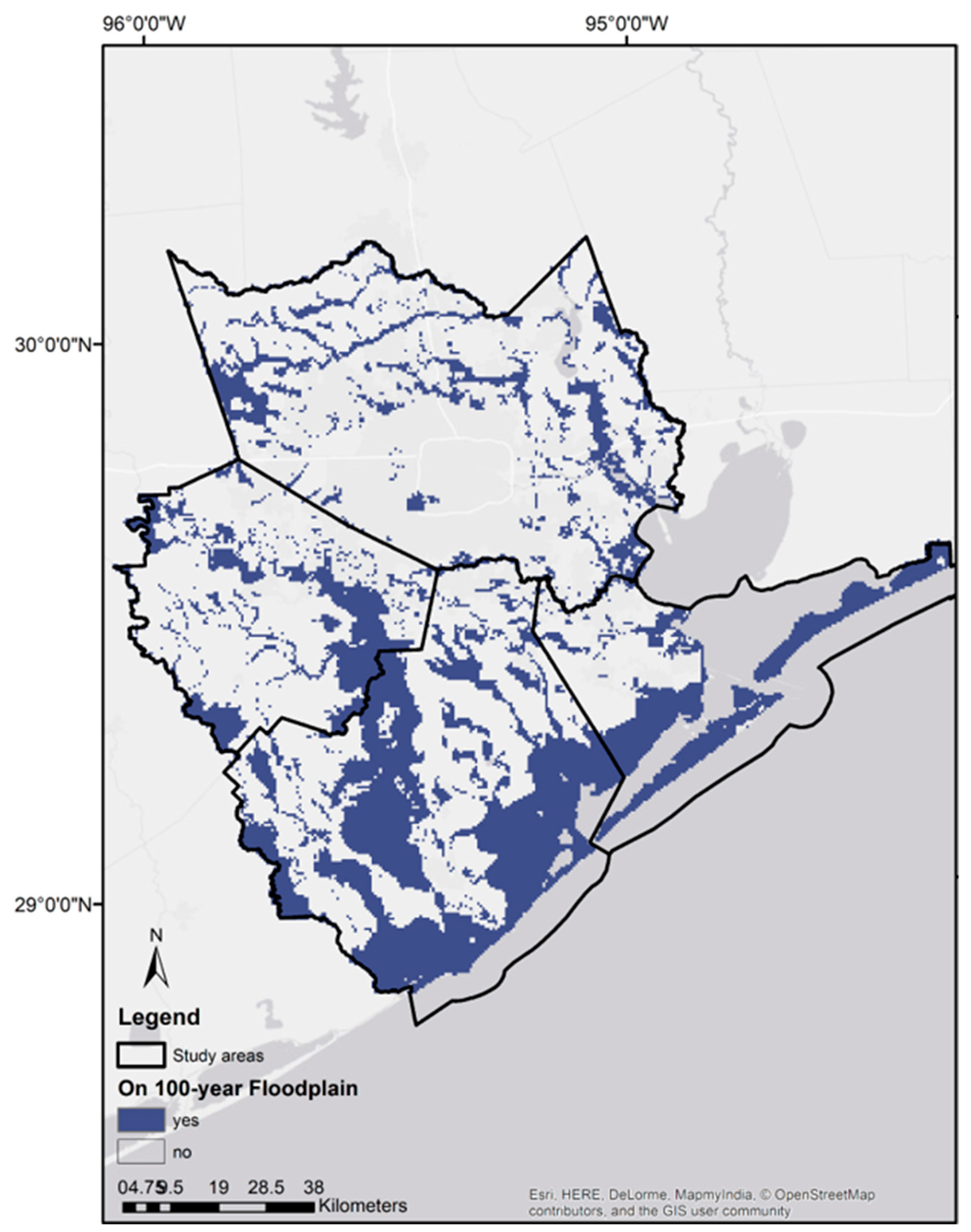
References
- Goodchild, M.F.; Glennon, J.A. Crowdsourcing geographic information for disaster response: A research frontier. Int. J. Digit. Earth 2010, 3, 231–241. [Google Scholar] [CrossRef]
- Frey, A.E.; Olivera, F.; Irish, J.L.; Dunkin, L.M.; Kaihatu, J.M.; Ferreira, C.M.; Edge, B.L. Potential impact of climate change on hurricane flooding inundation, population affected and property damages in Corpus Christi. J. Am. Water Resour. Assoc. 2010, 46, 1049–1059. [Google Scholar] [CrossRef]
- Mousavi, M.E.; Irish, J.L.; Frey, A.E.; Olivera, F.; Edge, B.L. Global warming and hurricanes: The potential impact of hurricane intensification and sea level rise on coastal flooding. Clim. Chang. 2011, 104, 575–597. [Google Scholar] [CrossRef]
- Negri, A.J.; Burkardt, N.; Golden, J.H.; Halverson, J.B.; Huffman, G.J.; Larsen, M.C.; McGinley, J.A.; Updike, R.G.; Verdin, J.P.; Wieczorek, G.F. The hurricane–flood–landslide continuum. Bull. Am. Meteorol. Soc. 2005, 86, 1241–1247. [Google Scholar] [CrossRef]
- Barr, J.; Cohen, J.P.; Kim, E. Storm Surges, Informational Shocks, and the Price of Urban Real Estate: An Application to the Case of Hurricane Sandy; Department of Economics, Rutgers University: Newark, NJ, USA, 2017. [Google Scholar]
- Larsen, M.C.; Simon, A. A rainfall intensity-duration threshold for landslides in a humid-tropical environment, Puerto Rico. Geogr. Ann. Ser. Phys. Geogr. 1993, 75, 13–23. [Google Scholar] [CrossRef]
- Philpott, S.M.; Lin, B.B.; Jha, S.; Brines, S.J. A multi-scale assessment of hurricane impacts on agricultural landscapes based on land use and topographic features. Agric. Ecosyst. Environ. 2008, 128, 12–20. [Google Scholar] [CrossRef]
- Foley, J.A.; DeFries, R.; Asner, G.P.; Barford, C.; Bonan, G.; Carpenter, S.R.; Chapin, F.S.; Coe, M.T.; Daily, G.C.; Gibbs, H.K. Global consequences of land use. Science 2005, 309, 570–574. [Google Scholar] [CrossRef] [PubMed]
- Giupponi, C.; Mojtahed, V.; Gain, A.K.; Balbi, S.; Biscaro, C. An Integrated Approach for Including Social Capacities, and Economic Valuation in Risk Assessment of Water Related Hazards in Uncertain Scenarios. In Proceedings of the 2014 7th International Congress on Environmental Modelling and Software, San Diego, CA, USA, 15–19 June 2014. [Google Scholar]
- 1Dalu, M.T.B.; Shackleton, C.M.; Dalu, T. Influence of land cover, proximity to streams and household topographical location on flooding impact in informal settlements in the Eastern Cape, South Africa. Int. J. Disaster Risk Reduct. 2018, 28, 481–490. [Google Scholar]
- 1Brody, S.D.; Gunn, J.; Peacock, W.; Highfield, W.E. Examining the influence of development patterns on flood damages along the Gulf of mexico. J. Plan. Educ. Res. 2011, 31, 438–448. [Google Scholar]
- Randolph, J. Environmental Land Use Planning and Management; Island Press: Washington, DC, USA, 2004; ISBN 1-55963-948-2. [Google Scholar]
- Brody, S.D.; Highfield, W.E. Open space protection and flood mitigation: A national study. Land Use Policy 2013, 32, 89–95. [Google Scholar] [CrossRef]
- Brody, S.; Blessing, R.; Sebastian, A.; Bedient, P. Examining the impact of land use/land cover characteristics on flood losses. J. Environ. Plan. Manag. 2014, 57, 1252–1265. [Google Scholar] [CrossRef]
- Mitch, W.; Gosselink, J. Wetlands; John Wiley and & Sons: New York, NY, USA, 2000; 920p. [Google Scholar]
- Bullock, A.; Acreman, M. The role of wetlands in the hydrological cycle. Hydrol. Earth Syst. Sci. Discuss. 2003, 7, 358–389. [Google Scholar] [CrossRef]
- Schmitt, T.G.; Thomas, M.; Ettrich, N. Analysis and modeling of flooding in urban drainage systems. J. Hydrol. 2004, 299, 300–311. [Google Scholar] [CrossRef]
- Schubert, J.E.; Sanders, B.F.; Smith, M.J.; Wright, N.G. Unstructured mesh generation and landcover-based resistance for hydrodynamic modeling of urban flooding. Adv. Water Resour. 2008, 31, 1603–1621. [Google Scholar] [CrossRef]
- Casanova, M.T.; Brock, M.A. How do depth, duration and frequency of flooding influence the establishment of wetland plant communities? Plant Ecol. 2000, 147, 237–250. [Google Scholar] [CrossRef]
- Zope, P.; Eldho, T.; Jothiprakash, V. Impacts of land use–land cover change and urbanization on flooding: A case study of Oshiwara River Basin in Mumbai, India. Catena 2016, 145, 142–154. [Google Scholar] [CrossRef]
- Wheater, H.; Evans, E. Land use, water management and future flood risk. Land Use Policy 2009, 26, 251–264. [Google Scholar] [CrossRef]
- O’Connell, P.; Ewen, J.; O’Donnell, G.; Quinn, P. Is there a link between agricultural land-use management and flooding? Hydrol. Earth Syst. Sci. 2007, 11, 96–107. [Google Scholar] [CrossRef]
- van Oldenborgh, G.J.; van der Wiel, K.; Sebastian, A.; Singh, R.; Arrighi, J.; Otto, F.; Haustein, K.; Li, S.; Vecchi, G.; Cullen, H. Attribution of extreme rainfall from Hurricane Harvey, August 2017. Environ. Res. Lett. 2017, 12, 124009. [Google Scholar] [CrossRef]
- Bedient, P.; Blackburn, J.; Gori, A.; Juan, A. Tropical Storm Harvey Summary Report; SSPEED Center, Rice University: Houston, TX, USA, 2017; p. 14. [Google Scholar]
- FEMA. Historic Disaster Response to Hurricane Harvey in Texas; FEMA: Austin, TX, USA, 2017.
- Ngamassi, L.; Malik, A.; Zhang, J.; Ebert, D. Social Media Visual Analytic Toolkits for Disaster Management: A Review of the Literature. 2017. Available online: http://idl.iscram.org/files/louisngamassi/2017/1511_LouisNgamassi_etal2017.pdf (accessed on 28 January 2019).
- Simpson, R.; Page, K.R.; De Roure, D. Zooniverse: Observing the world’s largest citizen science platform. In Proceedings of the 23rd International Conference on World Wide Web, Seoul, Korea, 7–11 April 2014; pp. 1049–1054. [Google Scholar]
- Humanitarian OpenStreetMap Team. Humanitarian OpenStreetMap. Retrieved Febr. 2018, 13. Available online: https://www.hotosm.org/tools-and-data (accessed on 29 January 2019).
- Goodchild, M.F. Citizens as sensors: The world of volunteered geography. GeoJournal 2007, 69, 211–221. [Google Scholar] [CrossRef]
- Longueville, B.D.; Luraschi, G.; Smits, P.; Peedell, S.; Groeve, T.D. Citizens as sensors for natural hazards: A VGI integration workflow. Geomatica 2010, 64, 41–59. [Google Scholar]
- Hochmair, H.H.; Juhász, L.; Cvetojevic, S. Data Quality of Points of Interest in Selected Mapping and Social Media Platforms; Springer: Berlin/Heidelberg, Germany, 2018; pp. 293–313. [Google Scholar]
- Li, S.; Dragicevic, S.; Castro, F.A.; Sester, M.; Winter, S.; Coltekin, A.; Pettit, C.; Jiang, B.; Haworth, J.; Stein, A. Geospatial big data handling theory and methods: A review and research challenges. ISPRS J. Photogramm. Remote Sens. 2016, 115, 119–133. [Google Scholar] [CrossRef]
- Lyons, S.W. Spatial and temporal variability of monthly precipitation in Texas. Mon. Weather Rev. 1990, 118, 2634–2648. [Google Scholar] [CrossRef]
- Qian, Z. Without zoning: Urban development and land use controls in Houston. Cities 2010, 27, 31–41. [Google Scholar] [CrossRef]
- US Census Bureau. TIGER/Line Tracts and Blocks; US Census Bureau: Suitland, MD, USA, 2017.
- Bengston, D.N.; Fletcher, J.O.; Nelson, K.C. Public policies for managing urban growth and protecting open space: Policy instruments and lessons learned in the United States. Landsc. Urban Plan. 2004, 69, 271–286. [Google Scholar] [CrossRef]
- Brakenridge, G.R.; Kettner, A.J. DFO Flood Event #4510; University of Colorado: Boulder, CO, USA, 2017. [Google Scholar]
- Bartier, P.M.; Keller, C.P. Multivariate interpolation to incorporate thematic surface data using inverse distance weighting (IDW). Comput. Geosci. 1996, 22, 795–799. [Google Scholar] [CrossRef]
- Pebesma, E.J. Multivariable geostatistics in S: The gstat package. Comput. Geosci. 2004, 30, 683–691. [Google Scholar] [CrossRef]
- R Core Team. R: A Language and Environment for Statistical Computing [Internet]; R Core Team: Vienna, Austria, 2014. [Google Scholar]
- Vaze, J.; Teng, J.; Spencer, G. Impact of DEM accuracy and resolution on topographic indices. Environ. Model. Softw. 2010, 25, 1086–1098. [Google Scholar] [CrossRef]
- Beven, K.J.; Kirkby, M.J. A physically based, variable contributing area model of basin hydrology/Un modèle à base physique de zone d’appel variable de l’hydrologie du bassin versant. Hydrol. Sci. J. 1979, 24, 43–69. [Google Scholar] [CrossRef]
- Gessler, P.E.; Moore, I.; McKenzie, N.; Ryan, P. Soil-landscape modelling and spatial prediction of soil attributes. Int. J. Geogr. Inf. Syst. 1995, 9, 421–432. [Google Scholar] [CrossRef]
- Ågren, A.; Lidberg, W.; Strömgren, M.; Ogilvie, J.; Arp, P. Evaluating digital terrain indices for soil wetness mapping—A Swedish case study. Hydrol. Earth Syst. Sci. 2014, 18, 3623–3634. [Google Scholar] [CrossRef]
- Xu, X.; Liu, W.; Scanlon, B.R.; Zhang, L.; Pan, M. Local and global factors controlling water-energy balances within the Budyko framework. Geophys. Res. Lett. 2013, 40, 6123–6129. [Google Scholar] [CrossRef]
- Hjerdt, K.; McDonnell, J.; Seibert, J.; Rodhe, A. A new topographic index to quantify downslope controls on local drainage. Water Resour. Res. 2004, 40. [Google Scholar] [CrossRef]
- Ballerine, C. Topographic Wetness Index Urban Flooding Awareness Act Action Support; Prairie Research Institute, University of Illinois at Urbana-Champaign: Will County/DuPage County, IL, USA, 2017. [Google Scholar]
- Sörensen, R.; Zinko, U.; Seibert, J. On the calculation of the topographic wetness index: Evaluation of different methods based on field observations. Hydrol. Earth Syst. Sci. Discuss. 2006, 10, 101–112. [Google Scholar] [CrossRef]
- R Core Team. R: A Language and Environment for Statistical Computing [Internet]; R Core Team: Vienna, Austria, 2017. [Google Scholar]
- Dormann, C.F.; McPherson, J.M.; Araújo, M.B.; Bivand, R.; Bolliger, J.; Carl, G.; Davies, R.G.; Hirzel, A.; Jetz, W.; Daniel Kissling, W. Methods to account for spatial autocorrelation in the analysis of species distributional data: A review. Ecography 2007, 30, 609–628. [Google Scholar] [CrossRef]
- Taper, M.L.; Ponciano, J.M. Evidential statistics as a statistical modern synthesis to support 21st century science. Popul. Ecol. 2016, 58, 9–29. [Google Scholar] [CrossRef]
- National Hurricane Center. Costliest U.S. Tropical Cyclones Tables Updated; NOAA: Miami, FL, USA, 2018.
- Elwood, S.; Goodchild, M.F.; Sui, D.Z. Researching volunteered geographic information: Spatial data, geographic research, and new social practice. Ann. Assoc. Am. Geogr. 2012, 102, 571–590. [Google Scholar] [CrossRef]
- Tulloch, D.L. Is VGI participation? From vernal pools to video games. GeoJournal 2008, 72, 161–171. [Google Scholar] [CrossRef]
- Johnson, P.A.; Sieber, R.E. Situating the adoption of VGI by government. In Crowdsourcing Geographic Knowledge; Springer: Berlin/Heidelberg, Germany, 2013; pp. 65–81. [Google Scholar]
- Poser, K.; Dransch, D. Volunteered geographic information for disaster management with application to rapid flood damage estimation. Geomatica 2010, 64, 89–98. [Google Scholar]
- Congalton, R.G.; Green, K. Assessing the Accuracy of Remotely Sensed Data: Principles and Practices; CRC Press: Boca Raton, FL, USA, 2008. [Google Scholar]
- Dovey, R. Next City. 2018. Available online: https://nextcity.org/daily/author/rachel-dovey (accessed on 28 January 2019).
- Brody, S.D.; Highfield, W.E.; Ryu, H.-C.; Spanel-Weber, L. Examining the relationship between wetland alteration and watershed flooding in Texas and Florida. Nat. Hazards 2007, 40, 413–428. [Google Scholar] [CrossRef]
- Morris, N. Health, Well-Being and Open Space; Edinburgh College of Art and Heriot-Watt University: Edinburgh, UK, 2003. [Google Scholar]
- Beatley, T. Planning for Coastal Resilience: Best practices for Calamitous Times; Island Press: Washington, DC, USA, 2012; ISBN 1-61091-142-3. [Google Scholar]
- Cammerer, H.; Thieken, A.H.; Lammel, J. Adaptability and transferability of flood loss functions in residential areas. Nat. Hazards Earth Syst. Sci. 2013, 13, 3063–3081. [Google Scholar] [CrossRef]
- Zellner, M.; Massey, D.; Minor, E.; Gonzalez-Meler, M. Exploring the effects of green infrastructure placement on neighborhood-level flooding via spatially explicit simulations. Comput. Environ. Urban Syst. 2016, 59, 116–128. [Google Scholar] [CrossRef]
- Seiler, R.; Hayes, M.; Bressan, L. Using the standardized precipitation index for flood risk monitoring. Int. J. Climatol. 2002, 22, 1365–1376. [Google Scholar] [CrossRef]
- Montz, B.E.; Tobin, G.A. The spatial and temporal variability of residential real estate values in response to flooding. Disasters 1988, 12, 345–355. [Google Scholar] [CrossRef]
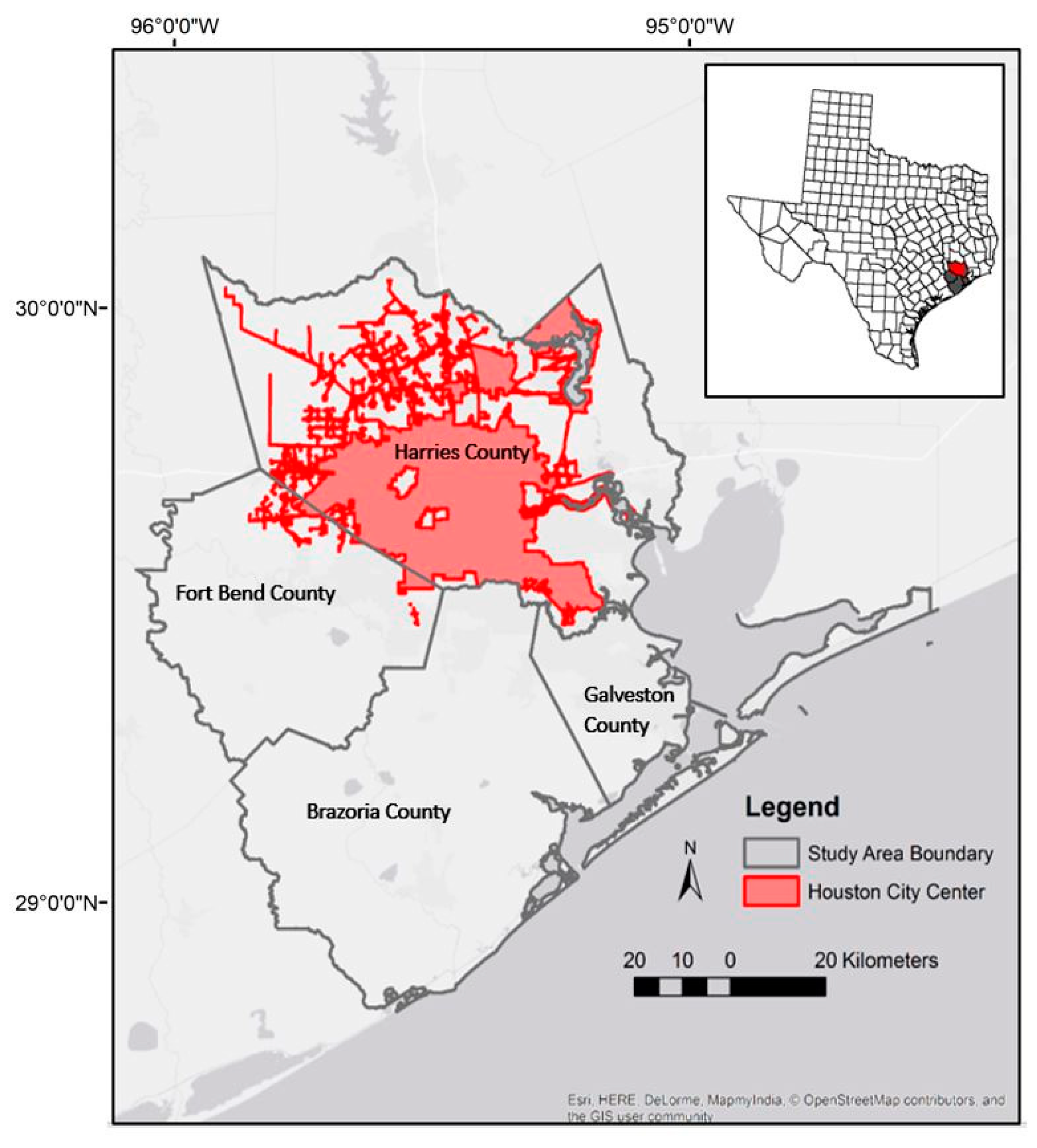
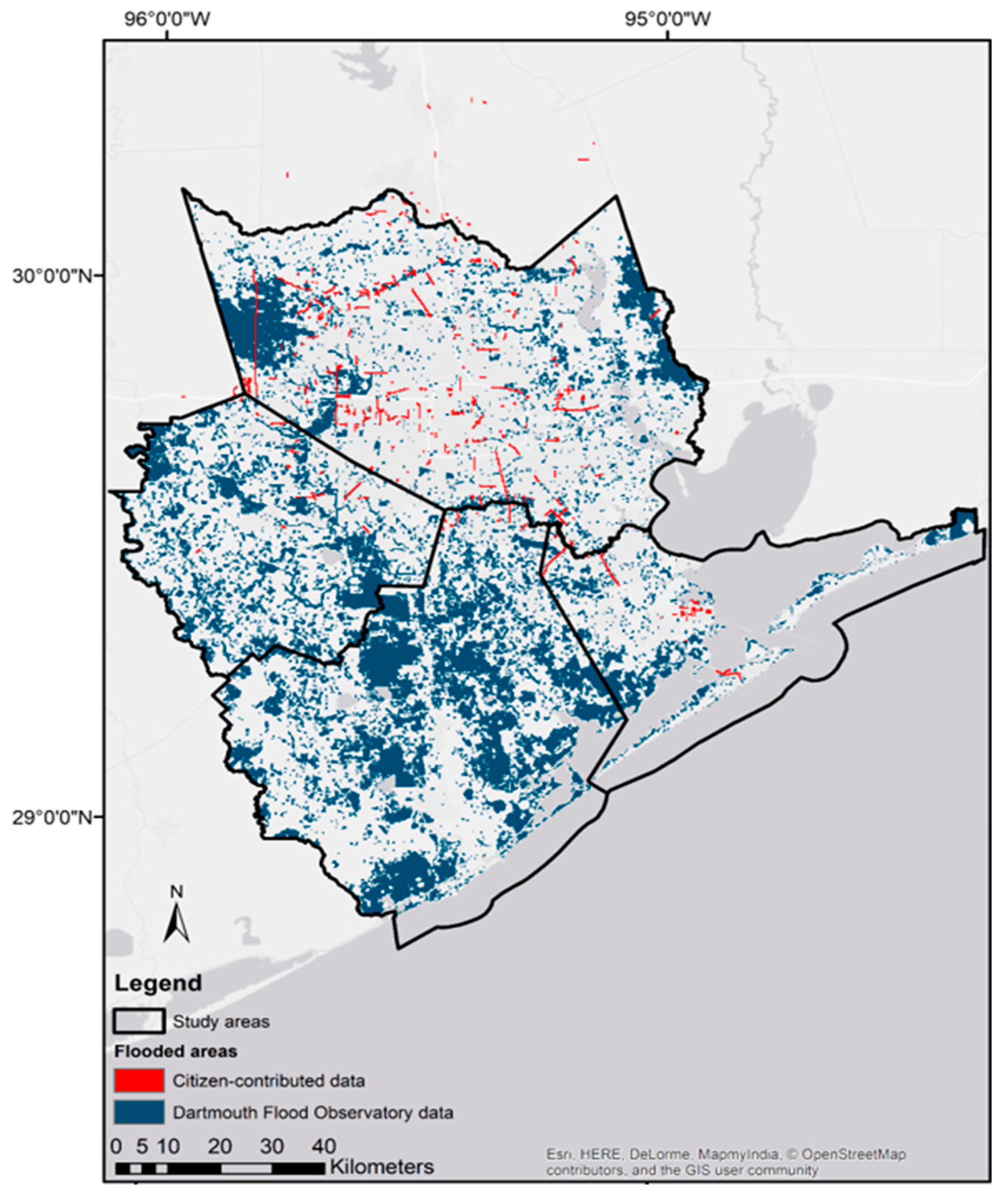

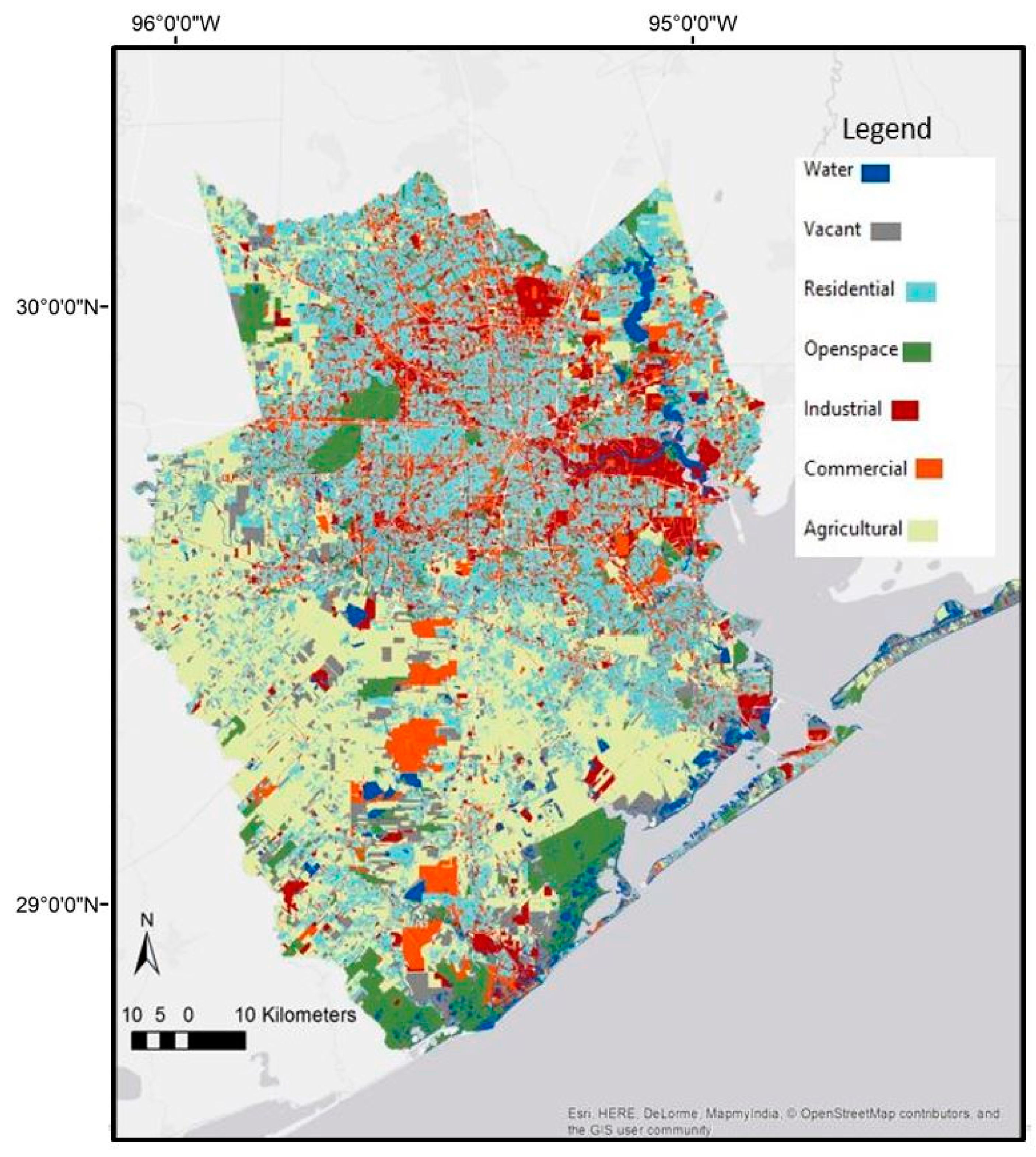
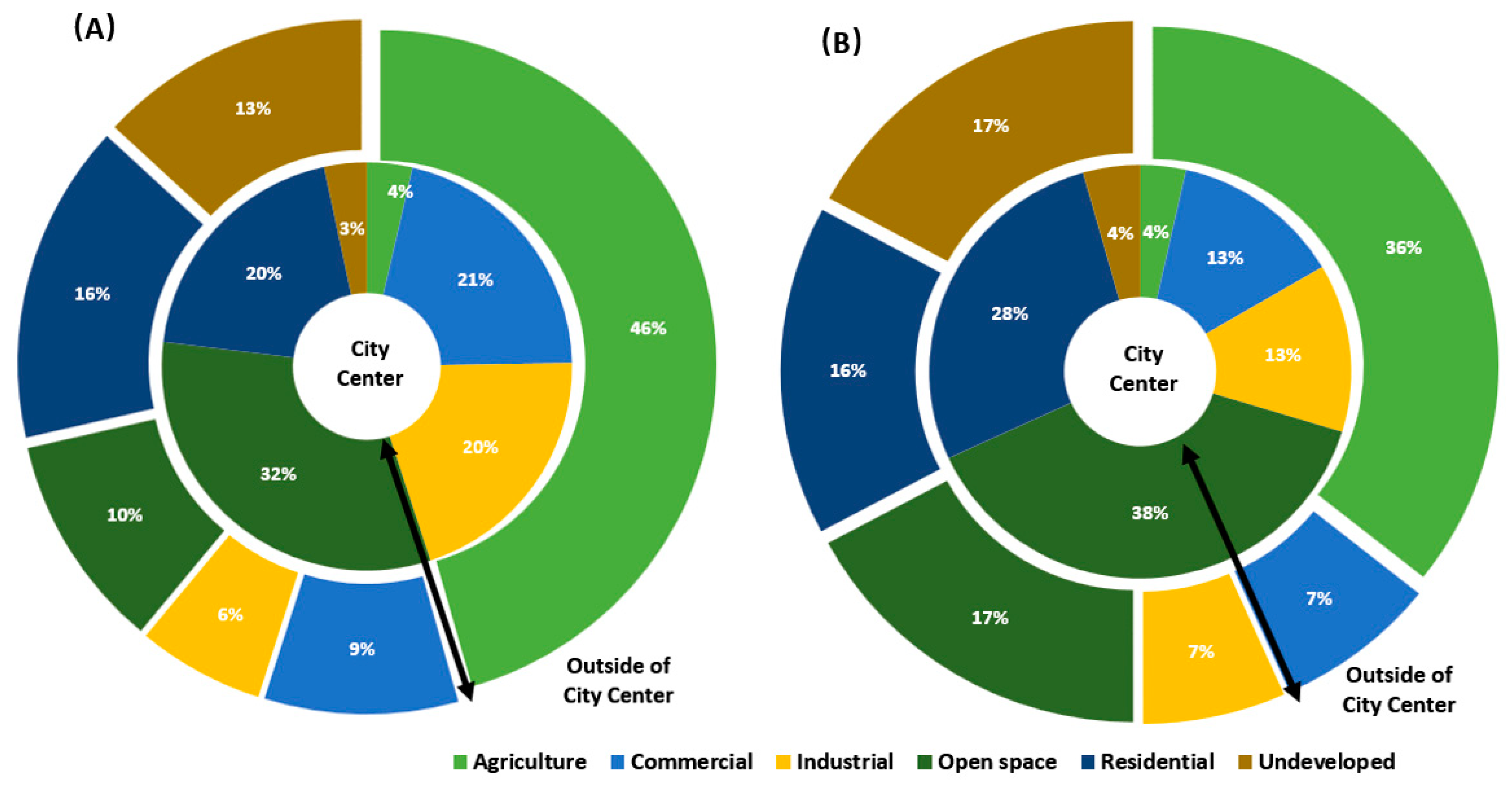
| Models | Log-Likelihood | χ2 | p-Value |
|---|---|---|---|
| Outside city center | |||
| flood ~ CTI + precipitation | −20,661 | - | - |
| flood ~ CTI + precipitation + floodplain + autocovariate term | −16,185 | 8951.49 | 2.2e–16 |
| flood ~ CTI + precipitation + floodplain + agricultural + industrial + commercial + open space + residential + autocovariate term | −15,952 | 465.94 | 2.2e–16 |
| Inside city center | |||
| flood ~ CTI + precipitation | −9308.2 | ||
| flood ~ CTI + precipitation + floodplain + autocovariate term | −7671.2 | 3274.03 | 2.2e–16 |
| flood ~ CTI + precipitation + floodplain + agricultural + industrial + commercial + open space + residential + spa autocovariate term | −7534.5 | 273.41 | 2.2e–16 |
| Outside of City Center | City Center | ||
|---|---|---|---|
| Variables | Coefficient | Variables | Coefficient |
| intercept a | −3.85 (−3.89, −3.81) | intercept a | −3.35 (−3.29, −3.41) |
| CTI b | −0.04 (−0.06, −0.02) | CTI a | −0.16 (−0.14, −0.18) |
| precipitation a | 0.28 (0.26, 0.30) | precipitation a | 0.20 (0.18, 0.22) |
| floodplain a | 1.44 (1.41, 1.47) | floodplain a | 1.02 (0.96, 1.08) |
| agricultural a | 0.33 (0.29, 0.37) | agricultural c | 0.16 (0.04, 0.28) |
| industrial c | 0.01 (−0.07, 0.09) | industrial a | 0.23 (0.16, 0.30) |
| commercial a | 0.77 (0.71,0.83) | commercial b | 0.16 (0.10, 0.22) |
| open space a | 0.25 (0.20, 0.30) | open space c | −0.08 (−0.16, 0.00) |
| residential a | −0.44 (−0.49, −0.39) | residential a | −0.76 (−0.69, −0.83) |
| spatial lags a | 18.27 (17.99, 18.55) | spatial lags a | 13.06 (12.68, 13.44) |
© 2019 by the authors. Licensee MDPI, Basel, Switzerland. This article is an open access article distributed under the terms and conditions of the Creative Commons Attribution (CC BY) license (http://creativecommons.org/licenses/by/4.0/).
Share and Cite
Yang, D.; Yang, A.; Qiu, H.; Zhou, Y.; Herrero, H.; Fu, C.-S.; Yu, Q.; Tang, J. A Citizen-Contributed GIS Approach for Evaluating the Impacts of Land Use on Hurricane-Harvey-Induced Flooding in Houston Area. Land 2019, 8, 25. https://doi.org/10.3390/land8020025
Yang D, Yang A, Qiu H, Zhou Y, Herrero H, Fu C-S, Yu Q, Tang J. A Citizen-Contributed GIS Approach for Evaluating the Impacts of Land Use on Hurricane-Harvey-Induced Flooding in Houston Area. Land. 2019; 8(2):25. https://doi.org/10.3390/land8020025
Chicago/Turabian StyleYang, Di, Anni Yang, Han Qiu, Yao Zhou, Hannah Herrero, Chiung-Shiuan Fu, Qiang Yu, and Jingyin Tang. 2019. "A Citizen-Contributed GIS Approach for Evaluating the Impacts of Land Use on Hurricane-Harvey-Induced Flooding in Houston Area" Land 8, no. 2: 25. https://doi.org/10.3390/land8020025
APA StyleYang, D., Yang, A., Qiu, H., Zhou, Y., Herrero, H., Fu, C.-S., Yu, Q., & Tang, J. (2019). A Citizen-Contributed GIS Approach for Evaluating the Impacts of Land Use on Hurricane-Harvey-Induced Flooding in Houston Area. Land, 8(2), 25. https://doi.org/10.3390/land8020025






